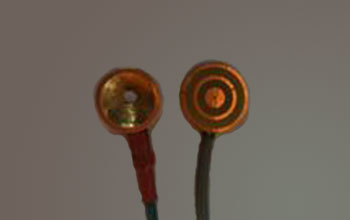Discovery
Simple Innovation to Electrodes Makes a Big Difference

Researcher expects improvements to epilepsy diagnosis and prevention of life-threatening seizures

Walt Besio developed a tripolar ring electrode, which is compared to a conventional electrode.
Credit and Larger Version
December 20, 2012
The electroencephalogram (EEG) for human uses has been around since 1924. Small metal discs placed along the scalp measure electrical activity in the human brain, important in diagnosing or evaluating epilepsy, sleep disorders and other conditions.
But these electrodes have changed little since their introduction, and are far from perfect. Among other things, they pick up extraneous noise and movement in addition to brain wave activity, often making the readings difficult to interpret.
Walt Besio thinks he has a better way.
The National Science Foundation-funded scientist, who is associate professor of biomedical engineering at the University of Rhode Island, has invented a new and improved electrode, one that produces a performance difference that he says is akin to "taking the rabbit ears you used to have for your television set, and converting to high definition."
His innovation is relatively simple, but apparently makes a big difference. Besio added two new metal rings around the basic disc, a change that eliminates outside noises and improves spatial resolution.
"EEG has two main problems: It's very noisy and contaminated with artifacts, and it's spatial resolution is bad," he explains. "We have improved the signal-to-noise ratio. It's four times better than it was before. Because it is now a very local signal, it means we can put electrodes closer together, which improves spatial resolution, meaning you can better determine where the signal is coming from."
The additional rings work almost like an inner tube tossed on top of a rippling body of water. "The water is flat in the center of the inner tube and choppy on the outside," he says. "The outer rings on the electrodes behave like that inner tube."
For researchers and clinicians, having improved electrodes could open up potential new uses, as well as improve current ones-more accurate epilepsy diagnosis, for example, as well as the promise of "reading" someone's thoughts in the future, with the goal, for example, of activating an otherwise inert body part, such as an arm or leg, and ultimately helping people with spinal cord injuries.
The aim is to have the highly sensitive electrodes first translate a person's thoughts into electrical impulses that can be read by a computer, then, eventually move to robots, and later, limbs. Other scientists are conducting similar research, but Besio wants to show "that it works better with these types of electrodes."
His work was inspired by the experiences of his older brother, who was paralyzed in an automobile accident, and died about 15 years ago.
"The hope is to interpret someone's thoughts using an electrode and the computer," Besio says. "The ultimate objective is to control some type of stimulation that will activate nerves and muscles, allowing them to move, to give people more independence and not have them be locked into a non-functioning body."
More immediately, however, Besio believes the new electrodes can improve epilepsy diagnosis, as well as help stop a common life-threatening type of seizure-status epilepticus-an acute, prolonged seizure that he estimates kills up to 40,000 people a year in the United States.
Using the electrodes to stimulate the brain may be effective in stopping such seizures, he says. He already has shown that it works in animals. "We were able to show we could stop that type of ongoing seizure in rats, a seizure that normally would kill them," he says.
He envisions a non-invasive or minimally invasive way for epileptics to wear the electrodes, under a cap or hat, perhaps, or just under the skin of the scalp. The device would detect when a seizure starts, then deliver a dose of electrical stimulation capable of turning it off.
At the moment, however, "what is driving this is the epilepsy diagnosis," he adds. "Clinicians need this improvement to help diagnose epilepsy. We are moving to get this recording system into the hands of researchers so they can do their brain research.
"Neurologists and neurosurgeons are pushing me to get this technology going," he adds. "They tell me there is a lot of misdiagnosis in epilepsy, and that they need something better than what they have. They need a better brain signal; the normal signal is very contaminated, and it's hard to see where a seizure is coming from."
In the fall of 2011, Besio was among the first group of scientists to receive a $50,000 NSF Innovation Corps (I-Corps) award, which supports a set of activities and programs that prepare scientists and engineers to extend their focus beyond the laboratory into the commercial world.
Such results may be translated through I-Corps into technologies with near-term benefits for the economy and society. It is a public-private partnership program that teaches grantees to identify valuable product opportunities that can emerge from academic research, and offers entrepreneurship training to faculty and student participants.
He has started a company, CRE Medical (the CRE stands for "concentric ring electrodes") with the hope of commercializing the technology, which also includes unique electronics that work with the electrodes. "We are partnering with other companies that want this technology." he says.
Moreover, "more than 75 percent of people with epilepsy live in developing countries and can't afford drugs," he says. "I'm hoping this will provide a low cost alternative."
--
Marlene Cimons, National Science Foundation
Investigators
Walter Besio
Related Institutions/Organizations
University of Rhode Island
CREmedical Corporation
Related Awards
#0933596 Tripolar Concentric Ring Electrodes (TCREs) for Brain Computer Interface
#1157882 I-Corps: Concentric Technology
#1248654 SBIR Phase I: Innovative Tripolar Concentric Ring Electrode Electroencephalography (tEEG) to Advance Epilepsy Diagnosis
Total Grants
$547,659





